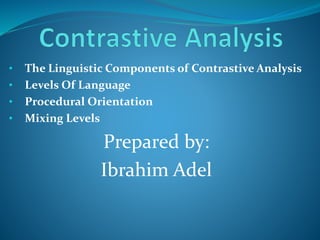
Contrastive Analysis.ppsx
- 1. • The Linguistic Components of Contrastive Analysis • Levels Of Language • Procedural Orientation • Mixing Levels Prepared by: Ibrahim Adel
- 2. The Linguistic Components of Contrastive Analysis Contrastive Analysis (CA) is a linguistic approach that aims to explain a second language. It involves comparing the learner's native language (L1) with the language they are learning (L2) through descriptive accounts and techniques. CA is not considered part of psycholinguistics because it separates the goals of psychology and linguistic study. CA is a form of linguistics with many forms, including macrolinguistics and micro-linguistics. Macro linguistics refers to the whole study of language. It is divided into three main subfields: prelinguistics, microlinguistics, and metalinguistics. Microlinguistics is a branch of macro linguistics referring to what may be called the “central core” of language study, i.e., the areas of phonology, grammar, and semantics. Linguistics provides the framework for CA, breaking down language into phonology, grammar, and lexis and describing them using categories such as unit, structure, class, and system.
- 3. 3.1 Levels of language Imagine meeting an eighty-year-old person who is the only person alive who speaks a language. As a linguist, it is your job to keep some accounts of this language as descriptive statements. Some of these descriptive statements are below: 1. This language (L) uses the sounds / e/ t/etc. 2. L has four words for ‘cousin’, depending on whether the cousin is a man or woman or on your mother’s or father's side of the family. 3. L shows a plurality of nouns in four different ways, each involving the addition of a consonant to the end of the noun in its singular form. 4. To ask a question, take the finite verb (the initial position in a declarative sentence) and transpose it to the sentence-final position.
- 4. Linguistic descriptions are approached using the principle ‘division of Labour’; each statement or group of statements aimed at one level of language restricts itself to some aspect of language, not covering several elements simultaneously. The more descriptive statements, the fuller the description becomes. The four statements of the hypothetical last surviving native speaker are made on different levels: phonology, lexis, morphology, and syntax.
- 5. 3.1.1 procedural orientation Traditionally, linguists describe languages by starting with phonology, then morphology, and finally syntax. This is because phonology is seen as essential and more accessible to explain in detail. However, linguists cannot determine the exact number of vocabulary items or syntactic patterns in a language, making it difficult to prove the essentiality of phonology. Nonetheless, every word or phrase in a language must adhere to phonological segments and syntactic rules. Phonemes are more commonly used in speech than morphemes or syntagms, but this does not necessarily mean they are essential. The focus on phonology in language description often overlooks other descriptive levels.
- 6. 3.1.2 mixing levels Structural linguistics initially prohibited mixing levels of description, but nowadays, it is allowed and sometimes necessary. Hetzron's study on Russian sentences demonstrates the importance of mixing levels to explain certain phonological features. Contrastive analysis follows the principle of linguistic levels, involving description and comparison stages. Interlingual level shifts occur when different languages express distinctions through different levels, such as from lexis to grammar or from phonology to lexis. These level shifts can be represented graphically to measure the degree of interlingual non-correspondence.
- 8. Thank You